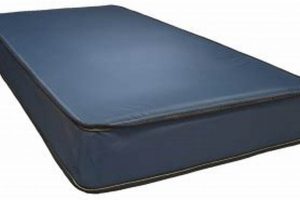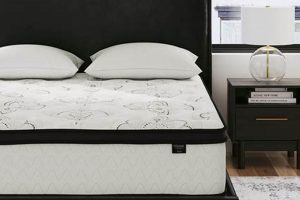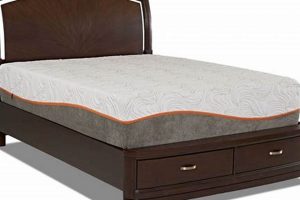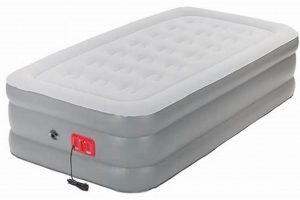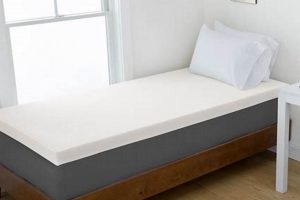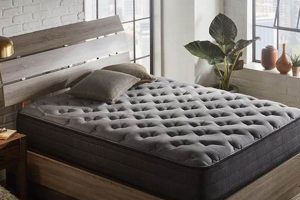The specifications of a single-person inflatable bed typically conform to industry standards established for conventional mattresses. This designation indicates a sleeping surface designed to comfortably accommodate one individual. For example, such a bed could measure approximately 39 inches in width and 75 inches in length, mirroring the dimensions of a standard bed of similar designation.
These compact inflatable beds are advantageous due to their portability and space-saving characteristics. They are suitable for temporary sleeping arrangements, accommodating guests, or travel. The reduced dimensions simplify storage and transport. Historically, these beds provided a convenient solution for situations where permanent beds were impractical, offering a blend of comfort and adaptability.
This article will examine the various construction materials used in these inflatable beds, the range of integrated features commonly available, and pertinent factors to consider when selecting one for purchase. Additionally, maintenance practices will be addressed to ensure longevity and sustained performance.
Considerations for Inflatable Single Beds
This section outlines crucial points to consider when selecting and utilizing a small inflatable bed. Attention to these details can enhance comfort, durability, and overall user satisfaction.
Tip 1: Evaluate Intended Use: Determine the primary purpose. Is it for occasional guests, camping, or a temporary living situation? The frequency of use will influence the required durability and features.
Tip 2: Assess Available Space: Measure the intended placement area. Although compact, ensure adequate clearance for inflation and comfortable movement around the bed.
Tip 3: Scrutinize Material Quality: Examine the material composition. Thicker, more robust materials resist punctures and air leakage. Look for PVC or reinforced nylon construction.
Tip 4: Investigate Inflation Mechanisms: Consider whether an integrated pump is preferred or if an external pump will be necessary. Integrated pumps offer convenience, while external pumps provide versatility.
Tip 5: Review Support Structure: Evaluate the internal support system. Coils or beams contribute to even weight distribution and prevent sagging.
Tip 6: Examine Surface Texture: Assess the bed’s surface. A flocked or textured surface enhances comfort and prevents bedding from slipping.
Tip 7: Understand Weight Capacity: Adhere to the manufacturer’s specified weight limit. Exceeding this limit can compromise the bed’s structural integrity.
Tip 8: Research Storage Solutions: Determine how the bed will be stored when deflated. A compact storage bag protects the bed from damage and simplifies organization.
Careful consideration of these aspects ensures a more informed purchase and a more satisfying experience with a small inflatable bed.
The subsequent sections will delve into maintenance procedures and common issues encountered with these beds.
1. Standard Dimensions
The term “Standard Dimensions” when applied to an inflatable bed of a specific designation refers to adherence to generally accepted industry measurements. In the context of a single-person inflatable bed, these dimensions typically approximate 39 inches in width and 75 inches in length. These measurements correlate directly with the interior space available for an occupant. Failure to conform to these standards could result in incompatibility with standard-sized bedding or reduced comfort for the user. For instance, a bed significantly shorter than 75 inches may prove unsuitable for taller individuals, leading to discomfort and potentially disrupting sleep patterns.
The practical significance of “Standard Dimensions” extends beyond mere convenience. Manufacturers adhere to these specifications to ensure interchangeability and consumer familiarity. Retailers stock bedding based on these established sizes, enabling consumers to readily find appropriate sheets and blankets. Furthermore, standardized dimensions facilitate the use of bed frames or platforms designed for single-person beds. Consider the scenario of an individual purchasing an inflatable bed intended for use with an existing bed frame; deviations from the standard width could render the bed unusable with the frame.
In summary, the relationship between “Standard Dimensions” and an inflatable bed is one of essential correspondence. Adherence to these dimensions ensures compatibility, user comfort, and seamless integration with existing bedding accessories. Deviation from these standards introduces potential challenges and compromises the practical utility of the bed. Therefore, understanding and confirming dimensions before purchase is critical for a satisfactory outcome.
2. Portability Advantage
The compact dimensions inherent in a single-person inflatable bed directly contribute to its enhanced portability. This advantage manifests in several key areas. Reduced weight and volume facilitate ease of transport and storage, allowing the bed to be readily moved between locations or stored in confined spaces when not in use. The deflated state further minimizes its physical footprint, making it suitable for situations where space is at a premium. A camping trip, for example, benefits significantly from the reduced bulk and weight, allowing for easier packing and transportation alongside other essential equipment. The portability factor eliminates the logistical challenges associated with transporting and storing a conventional mattress.
The implications of this portability extend beyond recreational use. Temporary housing situations, emergency shelters, and guest accommodations all benefit from the ease with which these beds can be deployed and retrieved. The compact nature of the deflated bed simplifies storage in closets, attics, or under beds, ensuring it remains readily available when needed without consuming excessive space. Consider the scenario of hosting an unexpected overnight guest; a small inflatable bed can be quickly inflated and deployed, providing a comfortable sleeping arrangement without requiring significant advance preparation or rearrangement of existing furniture.
In conclusion, the reduced dimensions are integral to the practicality and versatility of these inflatable beds. The portability advantage empowers users to adapt to changing circumstances, whether for leisure activities or unexpected accommodation needs. Overcoming the challenges of transporting and storing bulky sleeping arrangements, these beds provide a readily available and space-efficient solution. This enhanced portability represents a key differentiator when comparing with traditional mattresses.
3. Guest Accommodation
The provision of suitable sleeping arrangements for visiting guests often presents a logistical challenge, particularly in residences with limited space. Single-person inflatable beds address this challenge by offering a readily deployable and space-efficient sleeping solution.
- Space Optimization
Inflatable single beds require minimal storage space when deflated, facilitating their use in apartments or homes where dedicated guest rooms are unavailable. The deflated unit can be stored in closets, under beds, or in storage containers, occupying a fraction of the space required by a traditional bed. Their compact nature is particularly beneficial in urban living environments where space is often a premium.
- Rapid Deployment
These beds can be inflated quickly, providing an instant sleeping surface for unexpected guests or situations requiring temporary accommodation. Many models incorporate integrated electric pumps, streamlining the inflation process. This capability eliminates the need for advance preparation and allows hosts to readily accommodate visitors with minimal disruption.
- Cost-Effectiveness
Compared to investing in a full-sized bed or a pull-out sofa, inflatable single beds offer a more economical solution for guest accommodation. They provide a comfortable sleeping surface at a lower upfront cost, making them accessible to a wider range of homeowners and renters. This cost-effectiveness extends to the ease of maintenance and storage compared to traditional guest beds.
- Acceptable Comfort Level
While not intended to replace a permanent mattress, inflatable single beds can provide a satisfactory level of comfort for temporary sleeping arrangements. Features such as flocked surfaces and internal support structures contribute to enhanced comfort. Furthermore, the use of standard-sized bedding ensures guests can utilize familiar linens, contributing to a more comfortable experience.
In summary, inflatable single beds serve as a pragmatic solution for guest accommodation, offering a blend of space efficiency, rapid deployment, cost-effectiveness, and acceptable comfort. These attributes make them a valuable resource for households seeking to provide temporary sleeping arrangements without compromising space or budget constraints.
4. Space Efficiency
The characteristic of “space efficiency” is intrinsically linked to an inflatable bed of a particular designation. The compressed dimensions of such a bed when deflated directly correlate with the reduced storage footprint required. This attribute makes it a viable option for environments where available space is limited. The deflated bed can be readily stored in areas such as closets, under conventional beds, or within storage containers, thereby minimizing its impact on usable living space. This space-saving capability is particularly advantageous in apartments, dormitories, or smaller residences.
The efficient use of space afforded by these beds extends beyond mere storage considerations. Their temporary nature allows for the creation of sleeping arrangements without permanently dedicating floor area. Consider the scenario of accommodating overnight guests; an inflatable single bed can be deployed in a living room or spare room and subsequently deflated and stored, reclaiming the space for its primary function. This adaptability contrasts sharply with the commitment of space required by a traditional bed, which occupies a fixed area regardless of occupancy.
In summation, the space efficiency of an inflatable bed is not merely a convenient feature but a core attribute that dictates its suitability for specific applications. Its compact storage profile and temporary deployment capabilities address the challenges of space constraints in modern living environments. The practical implications of this feature underscore its importance in optimizing available space and enhancing the versatility of sleeping arrangements.
5. Budget Considerations
The relationship between budget and the purchase of an inflatable single bed is significant, representing a primary decision-making factor for many consumers. The cost-effectiveness of these beds, compared to traditional mattresses or sleeper sofas, positions them as a fiscally responsible option for temporary sleeping arrangements. This lower initial investment allows individuals with limited financial resources to secure a comfortable sleeping surface for guests, camping, or transitional living situations. The affordability factor is further amplified by the generally lower maintenance requirements associated with inflatable beds, reducing long-term costs. Real-world scenarios, such as students furnishing a dorm room or individuals temporarily relocating for work, frequently highlight the practical significance of these budget-conscious choices.
Further analysis reveals that budget considerations extend beyond the initial purchase price. Factors such as the lifespan of the inflatable bed and the potential need for accessories, like pumps or repair kits, also contribute to the overall cost. Higher-quality inflatable beds, while potentially more expensive upfront, often offer greater durability and resistance to leaks, minimizing the need for frequent replacements. Consumers also need to weigh the cost of electric pumps versus manual pumps, balancing convenience with energy consumption and purchase price. An example of practical application involves carefully comparing the total cost of ownership, including potential repairs and replacements, across different models before making a purchase decision.
In conclusion, budget considerations form a cornerstone of the decision-making process when selecting an inflatable single bed. The interplay between initial cost, durability, and potential ancillary expenses shapes the overall value proposition. Navigating these considerations effectively requires a comprehensive assessment of individual needs, usage patterns, and long-term financial implications, ultimately ensuring a cost-effective and satisfactory sleeping solution. Challenges include navigating the wide range of price points and feature sets to identify the optimal balance between affordability and quality.
Frequently Asked Questions
This section addresses common inquiries concerning inflatable beds designed for single occupancy, providing clarity on practical aspects and usage considerations.
Question 1: What are the typical dimensions of an inflatable bed designed for a single occupant?
Standard dimensions typically approximate 39 inches in width and 75 inches in length. However, slight variations may occur across different manufacturers. It is advisable to consult product specifications for precise measurements.
Question 2: What is the maximum weight capacity that an inflatable single bed can safely support?
Maximum weight capacity varies depending on the model and construction materials. Most inflatable single beds are designed to support between 250 and 300 pounds. Exceeding the specified weight limit may compromise the structural integrity of the bed and result in damage.
Question 3: How should an inflatable bed be properly stored when not in use
?
Prior to storage, the bed should be thoroughly deflated and cleaned. Folding the deflated bed neatly and storing it in a dedicated storage bag will protect it from punctures and minimize space consumption. It is recommended to store the bed in a dry, temperate environment to prevent material degradation.
Question 4: What types of materials are commonly used in the construction of inflatable single beds?
Common materials include PVC (polyvinyl chloride) and reinforced nylon. PVC offers durability and resistance to air leakage, while reinforced nylon provides enhanced strength and puncture resistance. Some models may incorporate a flocked surface for increased comfort.
Question 5: What is the recommended method for cleaning an inflatable bed?
A mild soap solution and a soft cloth are generally suitable for cleaning the surface of the bed. Harsh chemicals or abrasive cleaners should be avoided, as they may damage the material. Ensure the bed is thoroughly dry before storage.
Question 6: What are the common causes of air leakage in inflatable beds, and how can they be prevented?
Punctures from sharp objects are a primary cause of air leakage. Preventing leakage involves using the bed on a smooth, clear surface and avoiding contact with sharp objects. Seam failures and valve malfunctions can also contribute to leakage. Regular inspection and proper storage can mitigate these risks.
Proper usage and adherence to manufacturer guidelines will ensure longevity and optimal performance. Understanding these aspects promotes informed decision-making and efficient utilization of this bed type.
The next section will address troubleshooting techniques for common issues encountered with inflatable beds.
Conclusion
This examination of inflatable beds designated for single occupancy has clarified key aspects related to their dimensions, practicality, and application. The inherent space efficiency and portability offer distinct advantages in specific scenarios. Considerations regarding intended use, material quality, and adherence to weight capacity limits are paramount for ensuring user satisfaction and product longevity. Maintenance practices, including proper cleaning and storage, contribute significantly to extending the usable lifespan of these beds.
The information presented is intended to facilitate informed decision-making, enabling consumers to assess the suitability of an inflatable bed based on individual needs and circumstances. Further research into specific models and adherence to manufacturer recommendations are encouraged to optimize the utility and lifespan of the chosen product. The understanding of dimensions and construction is paramount for any application, recreational or for personal use.


